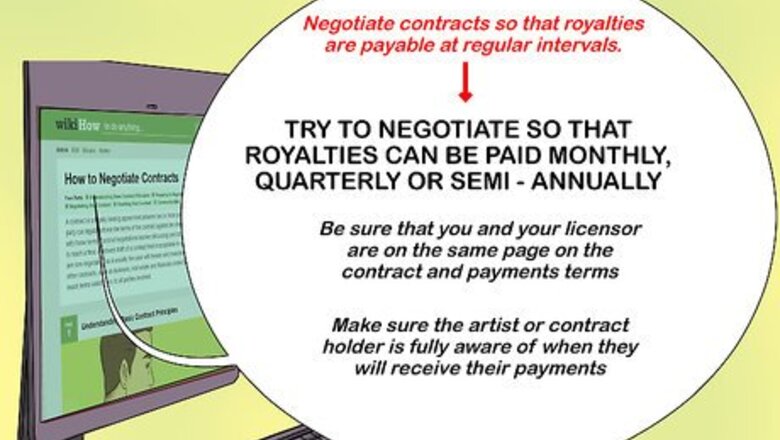
views
X
Research source
These licensees pay royalties to the creator, the licensor, either upon the sale of an item or each time an item is used.[2]
X
Research source
Royalty payments are made according to carefully constructed contracts, so it's important to employ an accurate accounting system to keep track of them. This ensures that payments are rendered in a timely manner and in the correct amount. Accounting processes vary based upon the nature of payments made and other contract stipulations, so it's important to know the specific entries required for each type of transaction.
Setting Up Payments
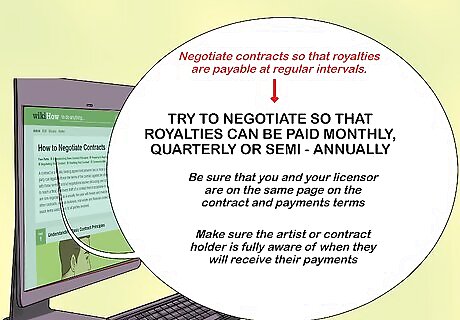
Negotiate contracts so that royalties are payable at regular intervals. If possible, negotiate royalties so that they can be paid monthly, quarterly or semi-annually. In any case, be sure that you and your licensor are on the same page on the contract and payments terms. Make sure the artist or contract holder is fully aware of when they will receive their payments.
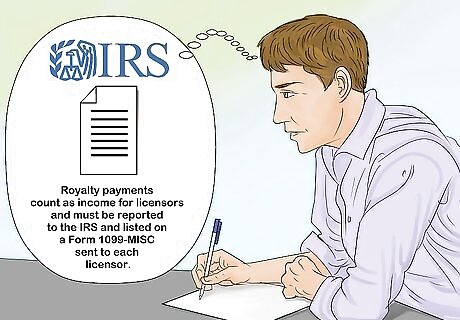
Collect tax information on each person who will be paid royalties. You will need this information to issue payment information for each licensor to the IRS. Royalty payments count as income for licensors and must be reported to the IRS and listed on a Form 1099-MISC sent to each licensor.

Decide how to account for royalties, based on the size of your business. The following are common ways that businesses account for royalties: If yours is a small business, such as an art gallery, make sure your accounting software and bookkeeping system include a section for royalties. It can be hard to find software that includes this option, so shop carefully. For example, Easy Royalties and Metacomet solutions can be some of the most affordable options, depending on your business model. If yours is a mid-sized business, hire a royalty accountant. Some accountants specialize in royalties, so they will be able to input a royalty-accounting system into your bookkeeping to ensure that all royalty payments are made on time. If you are in charge of a large business, set up a royalty department. This department may include accountants, information technology (IT) professionals, and lawyers. If you are constantly acquiring new products that involve royalty payments, or you are in a large-scale software, music, art or renewable-resource business, then this is the recommended path. You may also consider hiring an accounting firm as an outside royalty department.
Making Entries
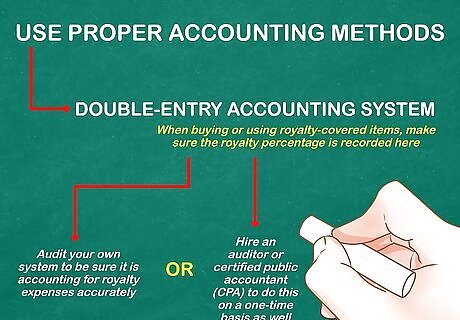
Record royalties using proper accounting methods. When buying or using royalty-covered items, make sure the royalty percentage is recorded in a double-entry accounting system. Audit your own system to be sure it is accounting for royalty expenses accurately. You can hire an auditor or certified public accountant (CPA) to do this on a one-time basis as well.

Be sure you are recording royalty payments at the right time. Generally accepted accounting principles (GAAP) dictate that expenses (the royalties in this case) be recorded when they are incurred. So, royalty expenses should be incurred when the sale of the licensed item is made.
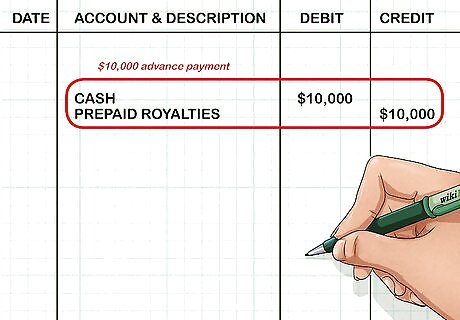
Account for advance payments. In many cases, a royalty contract will require an advance payment to a licensor. In this case, the licensee should record two entries at the full amount of the advance payment: a debit to prepaid royalties and a credit to the cash account. This reflects the payment of an advance as royalty payments paid early for future delivery of intellectual property. Any payments like this would also mean paying out cash from your cash account, which is reflected in the above crediting entry. For example, a $10,000 advance payment would be recorded as a $10,000 debit to prepaid royalties and a $10,000 credit to the cash account.
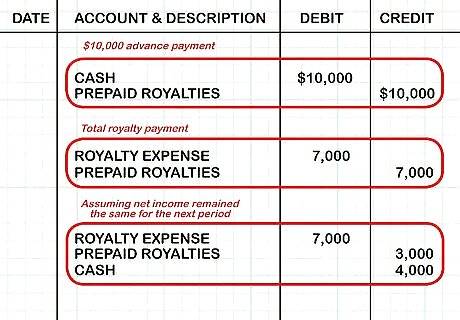
Account for regular payments. Some contracts stipulate that the licensee pay the licensor a percentage of net income over each quarter, month, or other designated period. These payments will be recorded as reductions to the prepaid royalty account until that account is depleted. After that, they are recorded as royalty expenses and reductions to the cash account. For example, imagine that the licensee who distributed the $10,000 advance payment in the example above owes the licensor 7 percent of net income, which totaled $100,000 for the current period. The total royalty payment, 7 percent of $100,000 or $7,000, would be debited to the royalty expense account and credited to the prepaid royalties account. Assuming net income remained the same for the next period, a different set of entries would be made. First, the royalty expense account would be debited for the full royalty amount, $7,000. The prepaid royalty account now only totals $3,000 ($10,000 original minus $7,000 from last period). So, this $3,000 would be credited to prepaid royalties and that account would be closed. Now, the remaining $4,000 would be credited to the cash account.
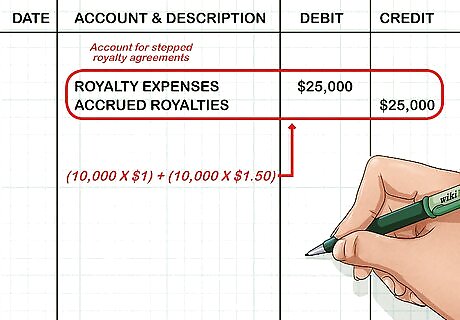
Account for stepped royalty agreements. Other royalty agreements create agreements where the licensor receives a greater royalty payment at different levels of sales. This is called a stepped royalty agreement and is recorded differently than a regular royalty payment. It is recorded in the ledger as a debit to royalty expense and a credit to accrued royalties (assuming the royalties are to be paid at the end of the period). For example, an author might receive $1 per book for the first 10,000 sold, then $1.50 per book for any sales after that. If 20,000 books are sold within this period, then the author would receive a total of $25,000 in royalty payments (10,000 x $1 + 10,000 x $1.50). This would be recorded as a $25,000 debit to royalty expenses and a $25,000 credit to accrued royalties. Any accrued liability is reduced at the end of the period the royalties are paid out.
Reducing Risk
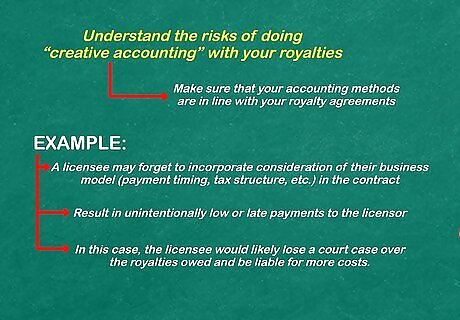
Understand the risks of doing "creative accounting" with your royalties. It is not uncommon for patent or copyright owners to sue for infringement, so you should make sure that your accounting methods are in line with your royalty agreements. By communicating clearly with your licensor and following the contract, you can avoid a lot of additional cost and legal hassle down the road. For example, some a licensee may forget to incorporate consideration of their business model (payment timing, tax structure, etc.) in the contract. This may result in unintentionally low or late payments to the licensor. In this case, the licensee would likely lose a court case over the royalties owed and be liable for more costs.

Save all paperwork that relates to the payment of royalties. Artists or patent-holders can and will ask for proof of sales, use and payments. Paperwork saved should include, in addition to the original contract, any ledger entries, financial statements, sales or payments receipts, and any additions or alterations made to the original agreement.
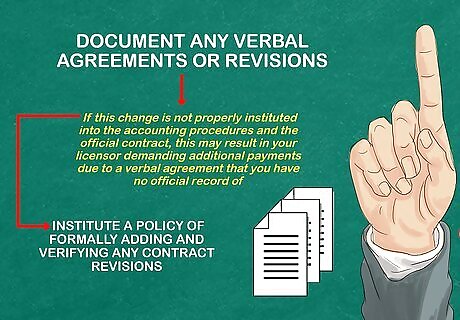
Document any verbal agreements or revisions. Either party to a royalty agreement may at any point verbally suggest or institute a change to the contract. If this change is not properly incorporated into the accounting procedures and the official contract, this may result in your licensor demanding additional payments due to a verbal agreement that you have no official record of. Be sure to institute a policy of formally adding and verifying any contract revisions to avoid this situation.

Issue checks whenever possible, so that you can provide proof of payment. Electronic payments are sometimes less detailed than paper checks. Whenever you reconcile accounts, your bank statements will reflect all royalty payments made by checks.
















Comments
0 comment